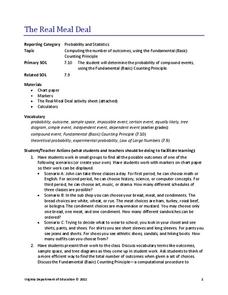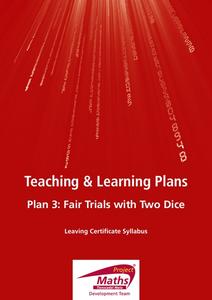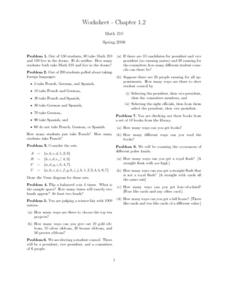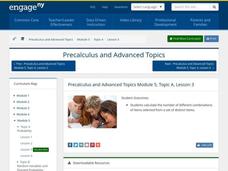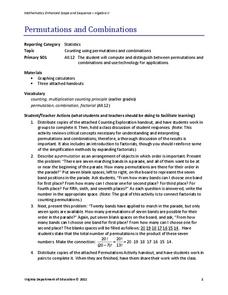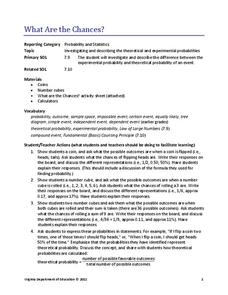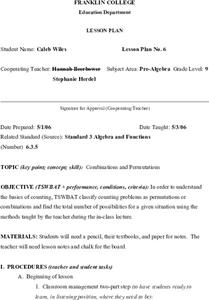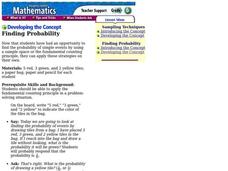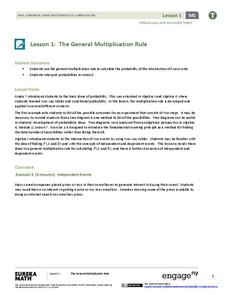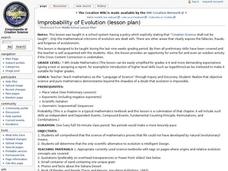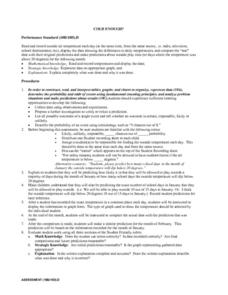Willow Tree
The Fundamental Counting Principle
How many different outfits can you make with what you have in your closet? The Fundamental Counting Principle can help you find an answer! Learners find totals using the Fundamental Counting Principle with problems that can have...
EngageNY
Counting Rules—The Fundamental Counting Principle and Permutations
Count the benefits of using the resource. The second installment of a 21-part module focuses on the fundamental counting principle to determine the number of outcomes in a sample space. It formalizes concepts of permutations and...
Virginia Department of Education
The Real Meal Deal
Burgers and salads and sodas, oh my! Scholars use a menu to investigate the Fundamental Counting Principle. They create tree diagrams to illustrate the number of possible choices for each given scenario.
Curated OER
Students use fundamental counting principle to compute combinations and permutations
Students define Pascal's triangle and special notations used to represent nth elements. In this geometry lesson, students solve problems using permutations and combinations. They compare the formula for permutation to that of Pascal's...
Project Maths
Fair Trials with Two Dice
Life's not fair, but dice games should be. After playing a two-person game with a pair of dice, scholars investigate the fairness of the game. They consider the number of possible outcomes using the fundamental counting principle and...
Curated OER
Worksheet - Chapter 1, 2 Combinations
In this combination worksheet, students draw Venn Diagrams, they determine the number of combinations of a particular event using tree diagrams or the fundamental counting principle. This one-page worksheet contains approximately eight...
EngageNY
Counting Rules—Combinations
Discover how combinations are different from permutations. In the third installment of a 21-part module, scholars learn how to determine combinations of objects. They learn to distinguish between situations where order is important and...
Virginia Department of Education
Permutations and Combinations
Counting is not all it adds up to be — sometimes it involves multiplying. The activity introduces permutations and combinations as ways of counting, depending upon whether order is important. Pupils learn about factorials and the...
Curated OER
Choices! Choices! Choices!
High schoolers explore the Fundamental Counting Principle and tree diagrams. In this secondary mathematics activity, students choose three pictures of clothing forma a catalog and create as many outfits as possible. High...
Curated OER
Data Analysis, Probability, and Discrete Math
Choose to supplement your probability unit with this resource and you won't be disappointed with the outcome. Teach young mathematicians to organize information using tree diagrams and lists in order to determine the possible outcomes of...
Curated OER
Computer Passwords
Students determine an appropriate numerical representation of a problem situation, including roots and powers. They determine an appropriate number of digits to represent an outcome. Pupils are asked to determine how many years it...
Virginia Department of Education
What Are the Chances?
Take a chance on an informative resource. Scholars conduct probability experiments involving coins and number cubes to generate data. Compiling class data helps connect experimental probability to theoretical probability.
Curated OER
Combinations And Permutations
Seventh graders investigate the mathematical concept using a lecture format. The lesson includes a classroom management section with suggestions for lesson execution. Students write a definition for the Fundamental Counting Principle....
Curated OER
How Many Jobs In A Loaf Of Bread?
Students develop career awareness and skill building for job performance. After completing an inventory of interests and skills, students link their career choice to a the agricultural components contained in their choice. Thy determine...
Curated OER
Finding Probability
Students demonstrate how to find the probability of events. For this probability lesson, students use colored tiles in a paper bag and randomly select one at a time to record the probability.
EngageNY
The General Multiplication Rule
In the first installment of a 21-part module, scholars build on previous understandings of probability to develop the multiplication rule for independent and dependent events. They use the rule to solve contextual problems.
Virginia Department of Education
Organizing Topic: Probability
The probability is high learning will occur! A well-designed unit introduces learners to the concepts of independent, dependent, and mutually exclusive events. Using Venn diagrams, the lessons ask learners to analyze many different...
Curated OER
Prairie Populations
Eleventh graders practice the Quadrat Survey Technique to analyze the biodiversity of a local plant community. They compare its biodiversity with the documented changes in biodiversity of the tallgrass prairie over time.
Curated OER
Improbability of Evolution
Students disprove evolution. In this science lesson, students disprove evolution by attempting to prove that creation is the way it all began. They use the improbability that evolution could exist and expose its fallacies, frauds and...
Council for Economic Education
New Sense, Inc. vs. Fish 'Till U Drop or Coase Vs. Pigou
Who is responsible for protecting the environment, and who should pay when it is damaged? The role of government and private industry is complicated. A role-play simulation prompts individuals to decide how to protect a fictitious town...
Curated OER
Combination and Permutations
Students decide when to use computation and permutation to solve problems. In this algebra lesson, students apply the correct method to solve complex set of events. They differentiate between dependent and independent events.
Curated OER
Cold Enough?
Students read and record temperatures and display the data. They represent the temperatures on an appropriate graph and explain completely what was done and why it was done. Students display the data showing differences in the daily...
Curated OER
Show Don't Tell
Students review the Show Don't Tell method of writing haiku poetry. They practice distinguishing poetic language from academic language and create poems based on images, not explanations.
Curated OER
Shapes and Introduction to Geometry
Learners make a quilt. In this geometry lesson, students discuss patchwork quilts and learn some different geometric shapes and patterns that are commonly used. Learners explore designs with triangles and squares and then make their own...


